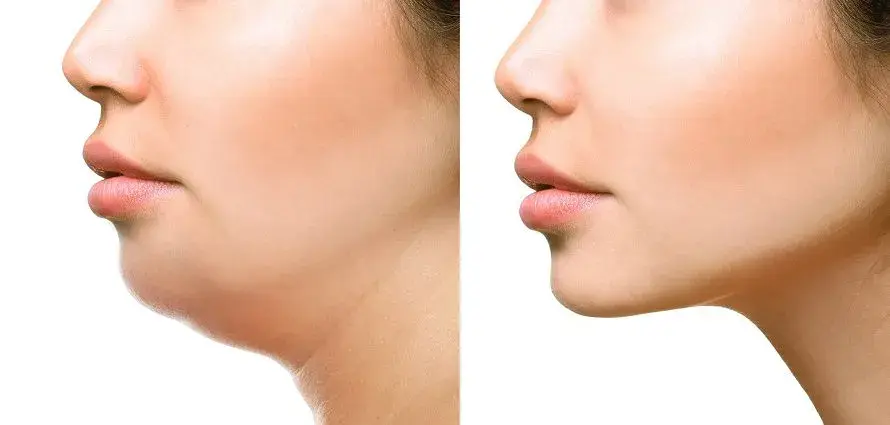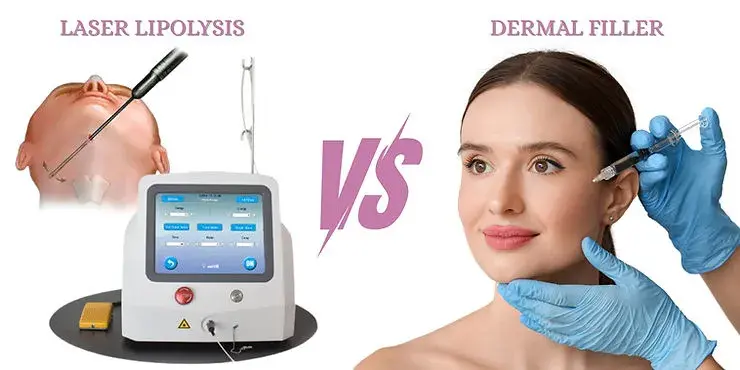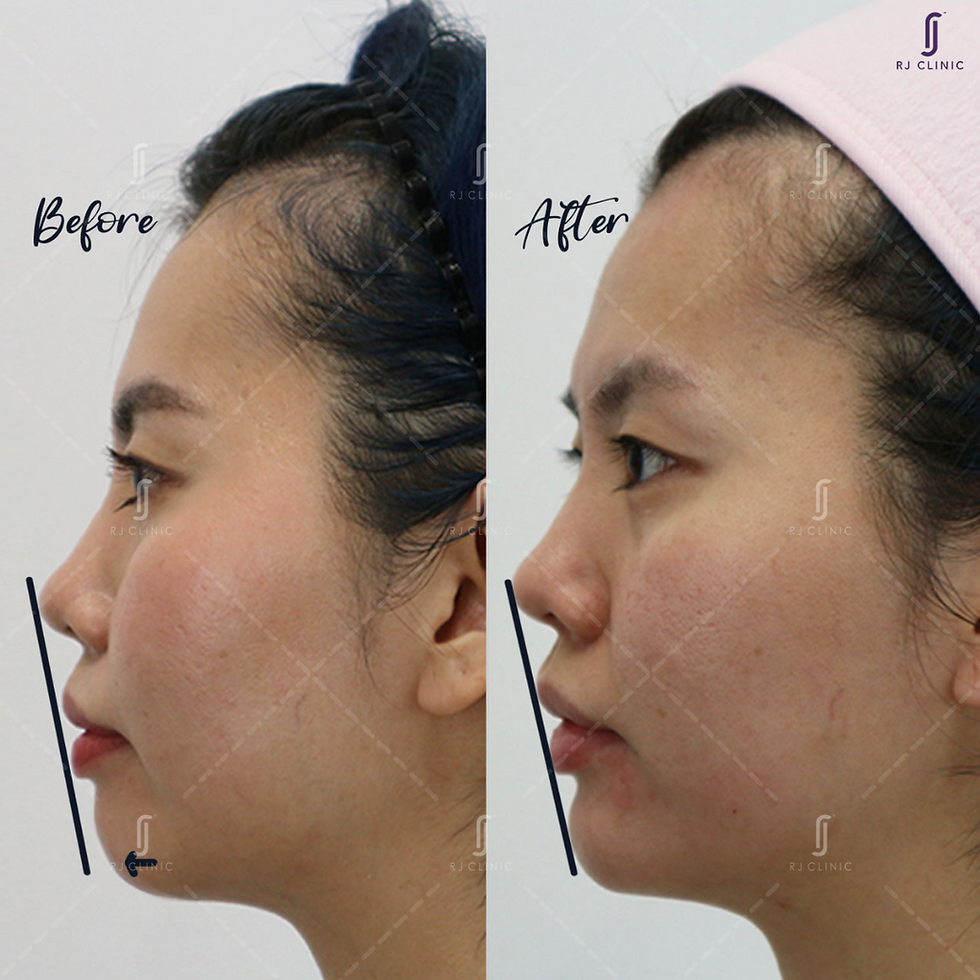Face Slimming Without Surgery Laser Lipo vs. Fillers
- Dr. Renee Law
- Jul 1
- 14 min read
Updated: Aug 13

Do you catch yourself angling your phone just right for selfies to hide those chubby cheeks? Or perhaps you've wondered why, despite being fit overall, your face seems stubbornly full? You're not alone.
As of June 2025, the quest for a slimmer, more contoured face has never been more popular—especially with non-surgical options becoming increasingly accessible.
The facial slimming market has exploded with alternatives to invasive surgery, with laser lipolysis and dermal fillers emerging as frontrunners. These treatments promise to sculpt and define your facial contours without the downtime and risks associated with traditional surgical procedures. While laser techniques use heat energy to target and eliminate stubborn fat cells, fillers strategically add volume to create the illusion of a slimmer face through enhanced definition. But which option is right for you? 🤔
In this comprehensive guide, we'll explore everything from why some faces appear fuller despite overall slimness, to the Korean beauty secrets for achieving that coveted V-shaped face. We'll take a deep dive into how laser lipo and fillers work, who makes an ideal candidate, and what you can realistically expect during these procedures—helping you make an informed decision that aligns perfectly with your facial aesthetic goals.
How can I make my face slim?

Looking for ways to slim down your face without going under the knife? You're not alone. Many people struggle with facial fullness even when they're at a healthy weight overall.
The simplest approach is making lifestyle changes. Reducing sodium intake helps decrease water retention that can make your face appear puffy. Staying hydrated, getting enough sleep, and cutting back on alcohol can also make a noticeable difference in facial definition.
Exercise matters too. While you can't spot-reduce fat from your face specifically, overall weight loss typically shows in your face first. Facial exercises may help tone the muscles under your skin, giving your face a more sculpted appearance over time.
For faster results, non-surgical treatments are increasingly popular. Laser lipolysis uses targeted heat to break down fat cells in specific areas of the face, particularly effective for double chins and chubby cheeks. The body naturally eliminates these broken-down fat cells over several weeks.
Dermal fillers work differently by strategically adding volume in certain areas (like cheekbones) to create contours and shadows that give the illusion of a slimmer face. This approach is particularly effective for people with flat cheekbones who want more definition.
Other options include radiofrequency treatments that tighten skin, ultrasound therapy that targets deeper tissues, and even specialized massage techniques that can temporarily reduce facial puffiness.
The right approach depends on your facial structure, budget, and how quickly you want results. Non-surgical treatments offer a middle ground between simple lifestyle changes and more invasive surgical procedures.
How do Koreans slim face?

Korean beauty standards have long emphasized slender, V-shaped faces, and Korean women have developed numerous techniques to achieve this coveted look without surgery. Their face slimming methods range from specialized skincare routines to modern technologies that have become popular worldwide.
Facial Massage Techniques
Koreans practice specific facial massage techniques that target facial bloating and promote lymphatic drainage. These massages focus on pressure points along the jawline and cheeks, helping to reduce water retention and define facial contours. Many Korean women perform these massages daily, often incorporating specialized tools like gua sha stones or facial rollers made from jade or rose quartz.
Facial Exercise Routines
Face exercises are another cornerstone of Korean face slimming methods. These include jaw clenching, cheek puffing, and tongue pressing exercises designed to tone facial muscles and create a more defined appearance. These exercises target the masseter muscles (the large chewing muscles at the corners of the jaw) which, when overdeveloped, can create a square-shaped face.
Technology-Based Treatments
RF (radiofrequency) treatments are extremely popular in Korea for face slimming. These non-invasive procedures use energy waves to heat deeper layers of skin, promoting collagen production and skin tightening along the jawline. Similarly, HIFU (High-Intensity Focused Ultrasound) treatments like Ultherapy have become staples in Korean aesthetic clinics for their ability to contour the lower face without downtime.
Botox for Jaw Reduction
Perhaps the most effective non-surgical Korean face slimming technique is masseter Botox. This procedure involves injecting small amounts of botulinum toxin into the masseter muscles, causing them to gradually shrink over time. The result is a slimmer, more oval-shaped face – the procedure has become so common in Korea that it's often considered as routine as getting a facial.
Dietary Approaches
Koreans also focus on reducing facial bloating through diet. Many avoid excessive salt, alcohol, and processed foods that contribute to water retention. Instead, they consume foods rich in collagen like bone broth and incorporate facial-slimming ingredients like ginger and green tea into their daily routines.
Why am I skinny but my face is chubby?

Ever looked in the mirror and wondered why your face looks fuller despite your slim body? You're not alone. This phenomenon—skinny body but chubby face—frustrates many people who eat right and exercise regularly.
It's actually pretty common and happens for several biological reasons.
First up: genetics. Your facial structure, including fat distribution, comes directly from your family tree. If your parents or grandparents had fuller faces, you probably inherited that trait. Genetics determines where your body stores fat, and for some people, that storage preference is in the cheeks and jawline.
Water retention plays a huge role too. When your body holds onto extra fluid, it often shows in your face first. Consuming too much sodium, not drinking enough water, or hormonal fluctuations can all make your face look puffier than the rest of your body.
Speaking of hormones, they're major culprits. Cortisol (the stress hormone) can trigger facial fat storage, while thyroid imbalances often cause facial swelling before affecting other body parts.
Age factors in significantly. As we get older, our facial fat pads shift and descend, creating that fuller appearance in the lower face and jawline area.
Muscle tension in the jaw area—often from teeth grinding or clenching—can make facial muscles appear larger and more prominent, creating that chubby-faced look.
The good news? There are multiple approaches to address this concern, from facial exercises to specialized treatments that can help create more definition without surgery.
Understanding Face Slimming Procedures

Exploring nonsurgical face slimming options
The beauty world is buzzing with options for those wanting a more defined facial structure without going under the knife. Nonsurgical face slimming has become wildly popular, especially among people who aren't ready for the commitment, recovery time, or cost of surgical procedures.
These minimally invasive treatments range from quick lunchtime procedures to slightly more intensive options that still get you back to your regular activities within days. The most sought-after treatments include laser lipolysis (which targets fat cells), injectable fillers (which add strategic volume), radiofrequency treatments, ultrasound therapies, and even specialized facial exercises.
What makes these options so appealing? They typically involve:
Little to no downtime
Gradual, natural-looking results
Lower risk profiles than surgery
Flexibility to adjust treatments over time
More affordable price points
Defining laser lipolysis for facial contouring
Laser lipolysis—sometimes called "laser lipo"—uses targeted laser energy to literally melt away stubborn facial fat deposits. The procedure works by heating fat cells until they break down, after which your body naturally flushes them out.
When used for facial contouring, a tiny laser fiber (about the size of a strand of spaghetti) is inserted through a minuscule incision. The practitioner then precisely targets problem areas like double chins, jowls, or chubby cheeks.
The genius of laser lipo for the face is its precision. Unlike traditional liposuction, the laser also stimulates collagen production, which helps tighten the skin as the fat disappears—giving you that coveted defined jawline or slimmer cheek profile.
Most people see results within 1-3 months as their bodies gradually process the disrupted fat cells. The results can be quite dramatic, especially for those struggling with genetic facial fullness that won't budge with diet and exercise.
How dermal fillers work for facial reshaping
Seems counterintuitive, right? Adding volume to slim down a face? But strategic filler placement is like facial architecture—it creates structure and definition where you need it.
Along the jawline to create definition
At the cheekbones to lift and contour
In the temples to balance proportions
The magic happens when skilled practitioners use fillers to create shadows and highlights—just like makeup contouring, but beneath the skin. By enhancing certain features, others recede visually.
Results appear instantly (unlike laser treatments), though there might be some initial swelling. Most fillers last 6-18 months depending on the product used and your metabolism.
Key differences between laser treatments and fillers
Choosing between these popular face slimming methods comes down to understanding what each one actually does to transform your face.
Feature | Dermal Fillers | Laser Lipolysis |
Primary action | Adds strategic volume | Removes fat |
Results timeline | Immediate | Gradual (1-3 months) |
Longevity | Temporary (6-18 months) | Permanent (if weight stable) |
Pain level | Mild (topical numbing cream) | Moderate (local anesthesia used) |
Downtime | 0-2 days of minor swelling | 3-7 days of swelling/bruising |
Best for | Creating contours and definition | Reducing facial fat pockets |
Sessions needed | Maintenance every 6-18 months | Typically 1-2 sessions |
Your facial structure, age, and specific concerns matter tremendously in determining which approach works better. Some people even benefit from combining both treatments—using laser lipo to reduce fat pockets and fillers to enhance structure in other areas.
The bottom line? Both techniques can dramatically slim and contour your face—they just take different routes to get there.
Deep Dive into Laser Lipolysis for Face Slimming

Types of laser treatments: minimally invasive vs. noninvasive options
When it comes to face slimming with laser lipolysis, you've got two main paths: minimally invasive or completely noninvasive treatments.
Minimally invasive laser treatments like Acculift use tiny incisions (we're talking 1-2mm) to insert a small laser fiber directly beneath your skin. This allows the laser to target stubborn facial fat with pinpoint accuracy, especially in areas like the jowls and under the chin. Recovery typically takes 2 weeks with some bruising and swelling, requiring to wear a face band for better skin redraping.
On the flip side, noninvasive options like Aqualyx only require a few injections with minimal downtime comparing to laser lipolysis. The trade-off? You'll likely need more sessions to see comparable results.
Here's a quick comparison:
Type | Procedure | Downtime | Sessions Needed | Best For |
Minimally Invasive (Acculift) | Small incision with laser fiber | 2 weeks | 1-2 sessions | Defined results, stubborn fat |
Noninvasive (Aqualyx) | External application | 0-1 day | 2-6 sessions | Mild fat reduction, maintenance |
How laser technology breaks down facial fat cells
The science behind laser lipo is actually pretty fascinating. When that laser energy hits your fat cells, it does something called "thermal lipolysis" – basically, it heats those cells until they can't take it anymore.
Fat cells are particularly sensitive to specific wavelengths of light, typically in the 1440nm range. When the laser hits them, it creates tiny holes in the cell membranes. The fat inside literally liquefies (turns from solid to liquid), then leaks out.
Your body's like, "What's this goop doing here?" and triggers an inflammatory response. White blood cells rush in to clean up, and your lymphatic system carries away the liquefied fat as waste.
The genius part? The laser energy is calibrated to only affect fat cells, leaving surrounding tissues (nerves, blood vessels, skin) virtually untouched. And once those fat cells are gone, they're gone for good – they don't regenerate, which is why the results can be long-lasting.
Typical treatment duration and process
A laser lipo session for your face isn't the all-day affair you might expect. Most treatments wrap up in about 30-60 minutes, making them perfect for lunch break beauty fixes.
For minimally invasive procedures, here's what happens:
Your face gets cleaned and marked for treatment
Local anesthetic is applied (you'll be awake but comfortable)
Tiny incisions are made, usually in hidden spots like under your chin
A thin laser fiber is inserted to target fat deposits
The liquefied fat might be suctioned out or left for your body to absorb
Small bandages cover the entry points – no major dressings needed
Injection treatments are even simpler:
Cleansing and marking the target areas
Applying the numbing cream to your skin's surface
Injecting the fat melting solution into targeted problematic areas
A quick cleanup and you're out the door
Most people describe the sensation as warm pressure or mild tingling – nothing unbearable. Some practitioners offer stress balls or entertainment to help pass the time, but honestly, many patients just chill or even nap during the procedure.
Expected timeline for visible results
Don't expect instant Instagram-worthy results with laser lipo. Your face will follow its own healing timeline.
For minimally invasive laser treatments, you'll notice:
Immediate post-treatment: Some swelling and maybe bruising (the "worse before better" phase)
1-2 weeks: Initial swelling subsides, slight improvements visible
1-3 months: The real magic happens as collagen remodeling occurs
6 months: Final results with sharper jawline and reduced fullness
Noninvasive methods follow a more gradual path:
Immediate post-treatment: mild swelling and bruising
2-4 weeks: Subtle improvements as your body begins clearing damaged fat cells
8-12 weeks: Progressive results becoming noticeable
Multiple sessions (usually 2-6) spaced 4-6 weeks apart for optimal results
Remember that your body's natural fat-clearing process takes time. The good news? As your body continues eliminating those destroyed fat cells, your results keep improving even after the treatment itself is finished.
Many patients report their face looks noticeably slimmer around the 3-month mark, with continued refinement for several months after.



Exploring Dermal Fillers for Facial Contouring

Strategic placement for creating slimmer facial appearance
Want to know the secret behind those enviable V-shaped faces? It's all about strategic filler placement. Skilled practitioners don't just inject randomly—they work like facial architects, adding volume in specific areas to create the illusion of a slimmer face.
The magic happens when fillers are placed along the jawline and chin to create definition and structure. A little extra volume at the chin can elongate the face, while targeted injections along the jawline create sharper angles that slim the overall appearance.
The cheekbones are another sweet spot. By adding volume higher on the cheeks, practitioners can draw attention upward, making the lower face appear narrower by comparison. It's like contouring with makeup, but from the inside out!
What makes this approach so brilliant is that it actually adds volume to create a slimmer look. Sounds contradictory, right? But it works because the human eye perceives facial proportions, not just size.
Types of fillers used for face slimming effects
Not all fillers are created equal when it comes to face slimming. The main players in this game include:
Hyaluronic Acid Fillers: Brands like Belotero fillers are popular choices for facial contouring. They're versatile, reversible (a huge plus!), and come in different consistencies. The firmer formulations work beautifully for jawline definition, while softer ones blend seamlessly into cheeks.
Calcium Hydroxylapatite (Radiesse): This heavier-duty filler provides stronger structural support, making it ideal for creating that sharp jawline or pronounced chin that can make a face appear slimmer.
Ellanse: Unlike immediate fillers, Ellanse works gradually by stimulating your own collagen production while retaining the volumetric and lifting effects. It's great for patients seeking subtle, progressive changes that look incredibly natural.
Each filler has its own personality and performance profile. Your face shape, skin condition, and desired outcome all factor into which one will work best for your slimming goals.
Immediate vs. long-term results
The instant gratification factor with fillers is off the charts. Walk into the clinic with a round face, walk out with defined contours. Most patients see about 90% of their results immediately, with the final 10% settling in over the next week as swelling subsides.
But what about staying power? That depends on the filler:
Hyaluronic acid fillers typically last 6-18 months
Radiesse can persist for 12-24 months
Sculptra's effects can last up to 2 years or more
What's fascinating is how these fillers integrate with your tissues over time. Hyaluronic acid gradually dissolves, while collagen-stimulating fillers like Sculptra create structural changes that evolve and improve over months.
Many patients report that even after fillers dissolve, their face maintains some of that sculpted appearance. This happens because quality fillers can improve skin quality and stimulate natural collagen production, leaving a lasting gift even after they're gone.
Maintenance requirements for optimal outcomes
Let's talk upkeep. Face slimming with fillers isn't a one-and-done situation—it's more like a relationship that needs regular attention.
For most patients, maintenance sessions every 6-12 months keep that sculpted look going strong. Your metabolism, age, and lifestyle all influence how quickly your body processes fillers, so your maintenance schedule is as unique as you are.
The good news? Many find they need less product during touch-up sessions. Your practitioner can build upon previous work, focusing just on areas that need refreshing rather than starting from scratch.
Smart maintenance includes these winning strategies:
Schedule touch-ups before fillers completely dissolve to maintain consistent results
Consider combination approaches (like adding skin-tightening treatments) to enhance and extend filler effects
Follow your provider's aftercare recommendations to maximize filler longevity
Your skincare routine matters too! Protecting your investment with sunscreen, antioxidants, and hydration can significantly extend your results between sessions.
The smartest approach is working with your provider to develop a personalized maintenance plan. This prevents the dreaded "filler fatigue" where continuous overfilling creates an unnatural appearance—keeping you looking refreshed, not fake.



Ideal Candidates for Non-surgical Face Slimming
A. Health considerations and contraindications
Not everyone's a good fit for non-surgical face slimming treatments. Before you book that appointment, here's what you need to know:
For laser lipo treatments:
You should be in generally good health
Pregnancy is a definite no-go
Those with pacemakers can't undergo the procedure
Active skin infections or open wounds in the treatment area will disqualify you
Certain medications that increase photosensitivity might be problematic
For facial fillers:
Bleeding disorders or use of blood thinners increase complication risks
Autoimmune conditions may lead to unpredictable results
Allergies to filler ingredients (though rare with modern products)
Active infections near the injection site are dangerous
Both treatments aren't suitable if you have unrealistic body image issues or body dysmorphia. These procedures are about enhancement, not complete transformation.
B. Realistic expectations for both procedures
Let's get real about what these treatments can actually do:
Laser lipo for face slimming:
Reduces fat by 20-25% in treated areas
Results develop gradually over 6-12 weeks
Won't fix severe jowls
Usually can achieve big difference with a single session
Fat reduction is permanent (as long as weight remains stable)
Facial fillers for contouring:
Create immediate definition along jawline and cheekbones
Can't actually remove fat—they create the illusion of a slimmer face
Results last 9-18 months depending on product used
Limited ability to address extreme facial roundness
Results are fully reversible (in case you don't like them)
Both options offer subtle improvements—they won't make you look like a completely different person. The best candidates expect refinement, not radical change.
C. Who benefits most from laser treatments vs. fillers
Laser treatments work wonders for:
People with localized fat deposits in the lower face or under the chin
Those with good skin elasticity who won't end up with sagging after fat reduction
Patients wanting permanent results without maintenance treatments
People who don't mind waiting for gradual improvements
Those who prefer no foreign substances in their body
Fillers are ideal for:
People with naturally thin faces wanting strategic volume for contour
Those with hollowing in certain areas alongside fullness in others
Patients wanting immediate results for an upcoming event
People wanting to "test drive" a new look before considering permanent options
Those with age-related volume loss alongside fullness in other areas
Your face structure fundamentally determines which approach will work better. Some people even benefit from combining both—using lasers to reduce fat pockets and fillers to enhance structure.
D. Age considerations for optimal results
Age plays a huge role in treatment selection and outcomes:
20s-30s:
Laser lipo works exceptionally well due to excellent skin elasticity
Results are more predictable as skin bounces back after fat reduction
Fillers can create dramatic sculpting effects without looking unnatural
Prevention of future aging concerns is a bonus benefit
40s-50s:
Laser treatments still effective but may need skin tightening added
Risk of skin laxity after fat reduction increases
Fillers become more strategic—addressing both contouring and age-related volume loss
Combined approaches often yield best results
60s and beyond:
Laser fat reduction alone may worsen appearance of skin laxity
Fillers become more about restoring lost structure than pure contouring
Smaller, more conservative treatment areas are recommended
Realistic expectations become even more important
The sweet spot for most nonsurgical face slimming treatments is between 30-55 years old, when you have enough tissue to work with but still maintain good skin quality. That said, careful assessment can identify good candidates of any age.
Both treatments benefit from ongoing healthy habits. That face-slimming effect won't last if you gain significant weight or skip your skincare routine. Your provider should give you personalized aftercare instructions based on your specific treatment plan and facial structure.
When considering face slimming options, both laser lipolysis and dermal fillers offer effective non-surgical alternatives to traditional facial contouring procedures. Laser lipolysis targets and eliminates excess facial fat through controlled laser energy, with results becoming visible within three months. Meanwhile, dermal fillers provide immediate sculpting effects by strategically adding volume to create the illusion of a slimmer face. Your choice ultimately depends on whether you need fat reduction or facial reshaping to achieve your desired look.
Before pursuing any face slimming procedure, consult with our doctors who can evaluate your unique facial structure and recommend the most appropriate treatment. Remember that these procedures work best for candidates in good health with realistic expectations. While both options offer minimal downtime compared to surgical alternatives, maintaining a healthy lifestyle will help preserve your results long-term. Your face is your most visible feature—choose the solution that not only enhances your appearance but also boosts your confidence.




Comments